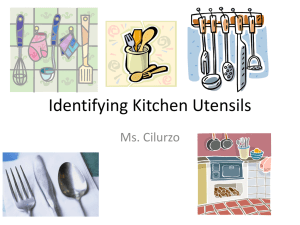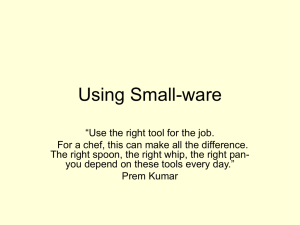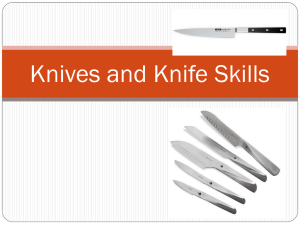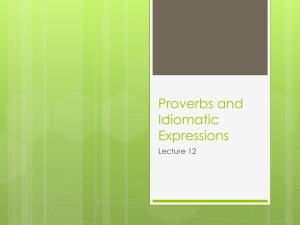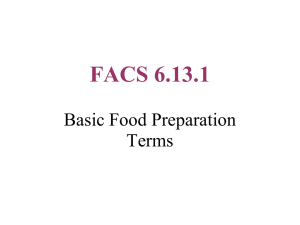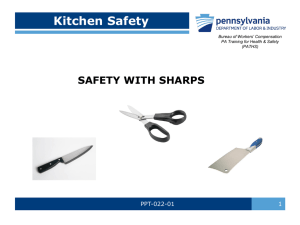KNIFE SKILLS
advertisement
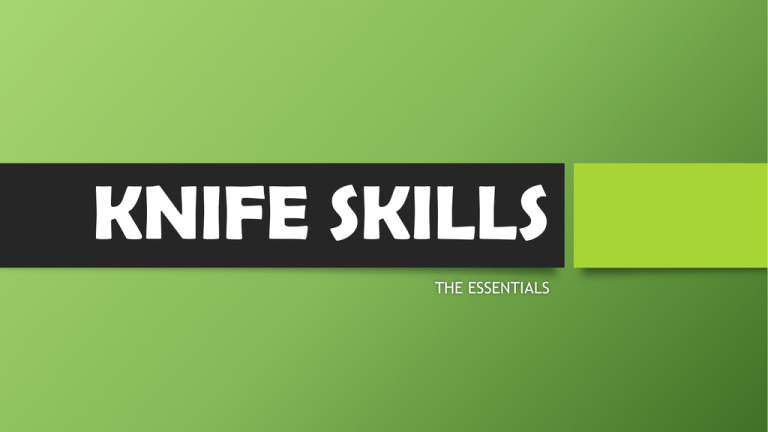
KNIFE SKILLS THE ESSENTIALS The Knife: An Essential Tool • The knife can be considered the chef’s most important and widely used tool. For this reason it is essential that food service professionals be aware of the following: • • • • • • Types of knives and their uses Knife safety Parts of a knife How to sharpen a knife Use of a knife (grip, guide and motion) Basic knife cuts The Right Tool • Because the knife essentially becomes an extension of a chef’s hand, it is important to select the right knife for the task. There are several options including (but not limited to): • • • • • • Chef Knife Slicers Utility Knife Serrated Slicers Boning Knife Paring Knife We will look at each in more detail. CHEF KNIFE • This knife is also sometimes referred to as a French knife and is the most used knife in the professional kitchen. Chef knives vary in size from 8-14 inches with the 10 inch blade being the most popular length. This knife is great for a variety of cuts because of its wide blade and tapered point. SLICERS • Slicers have long, narrow, flexible blades. The blade can be serrated (teeth that look like a saw) or smooth. Serrated slicers are best for cutting breads and pastries, while non-serrated slicers are ideal for slicing meats and other products. SERRATED THINK ABOUT IT: Why would a serrated blade be better for slicing breads and baked goods? BONING & FILET KNIFE • The blade of a boning knife is shorter and much thinner than that of a chef knife. The blade is also made to be very flexible. Filet knives have the most flexible blades as they are used to filet and portion fish. Boning knives are a little less flexible as they must be able to separate muscle from bone in various THINK ABOUT IT: Why would a flexible blade be meats and poultry. useful when fileting a fish? PARING KNIFE With the right tools and lots of skilled practice you can make beautiful creations too! • Paring knives are made to peel or cut away the skin of various fruits and vegetables. Paring knives are short and have small blades making them easier and safer to handle for this task. They are also a great tool for produce carving and detailed garnish work. NO MATTER THE KNIFE… • Each knife has the same parts. • These include: NO MATTER THE KNIFE… • SAFETY IS IMPORTANT! • Let’s watch a quick video highlighting the basics of knife safety. http://www.youtube.com/watch?v=LYZ1F8qSIBE A SHARP KNIFE IS A SAFE KNIFE • It may sound strange, but a sharp knife is a safe knife. Therefore, it is important to know how to properly sharpen your knives. Let’s watch this quick video showing us how to sharpen a knife using a steel. http://www.youtube.com/watch?v=syvvxx3eGpI USING A KNIFE • While you have probably seen the TV chefs working very quickly with their knives; it is most important to learn accuracy, precision, and safety before attempting to work quickly. When it comes to knife skills the accuracy persists over speed. As you become more comfortable with your knife and knife skills you may begin to increase efficiency. GRIP, GUIDE, AND MOTION • The first step is to find a grip that is appropriate and comfortable for you. LET’S DISCUSS WHY THE FIRST 2 GRIPS ARE INCORRECT. GRIP, GUIDE, AND MOTION • Once you’ve obtained the proper grip you need to determine the safest and best placement for your other hand. This will vary slightly dependent upon what you are cutting, but will almost always be some version of “The Claw” shown to the right. THINK ABOUT IT: Why is the claw a good position for your guiding hand? GRIP, GUIDE, AND MOTION http://www.youtube.com/watch?v=20gwf7YttQM • The cutting motion should be fluid. The knife stroke should start with the tip of the knife pointed toward the cutting board, then in one motion the knife blade should glide smoothly forward. This is sometimes referred to as a rocking motion. The motion should move away from your body. Let’s watch a short video clip to see what this should look like all together. CLASSIC KNIFE CUTS • There are several knife cuts. We will focus on the basics. They an be categorized into 3 main categories: • SLICES • STICKS • DICES SLICES “RONDELLE” or sliced carrots • Most knife cuts begin with a slice. When executed correctly all slices should be the same thickness. To keep round foods from rolling all over your cutting board it is sometimes necessary to trim part of the product and create a flat working surface. The most common type of slice is a rondelle. A rondelle is a slice from a round food such as a carrot, cucumber, or onion. STICKS • Foods cut into sticks are used often in the commercial kitchen. Most dices first require foods be cut into sticks. The 2 most common stick cuts are batonnet and julienne. A batonnet measures 2 X ¼ X ¼ inch while a julienne measures 2 X 1/8 X 1/8. DICES • To make a dice you simply cuts sticks across to make cubes. Dices can come in a variety if sizes including; large dice (sometime referred to as chop) measuring ¾ X ¾ X ¾, medium dice measuring ½ X ½ X ½ inch, small dice measuring ¼ X ¼ X ¼ inch, measuring 1/8 X 1/8 X 1/8 inch. THINK ABOUT IT: If dice cuts start as stick cuts; what stick cut would you start with to achieve an accurate brunoise? MINCING • Mincing requires that food be cut into very fine pieces and is ideal for foods like herbs, garlic and sometimes onions.

